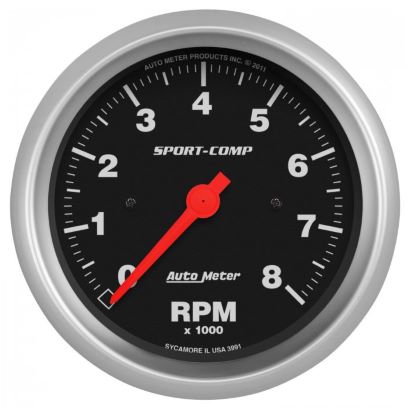Discovering the Functions and Advantages of a Tachometer: A Comprehensive Guide for Cars And Truck Fanatics
In the realm of automotive instrumentation, the tachometer stands as a vital tool that provides chauffeurs useful understandings right into their automobile's efficiency. tachometer. From providing real-time data on engine speed to aiding in optimizing equipment changes, the tachometer works as more than just a dial on the dashboard. Its complex features not just boost driving experience however also play a critical role in maintaining engine health and performance. As we delve right into the detailed operations and advantages of a tachometer, a deeper understanding of its significance for car fanatics and specialists alike will certainly unfold.
Comprehending the Fundamentals of a Tachometer
In the realm of automotive instrumentation, recognizing the fundamentals of a tachometer is important for any car fanatic wanting to explore the intricacies of engine performance surveillance. A tachometer, typically displayed on the control panel of a vehicle, gauges the engine's transformations per min (RPM) This critical instrument gives real-time data on just how quickly the engine crankshaft is rotating. By keeping an eye on the RPM, vehicle drivers can guarantee they are operating within the optimum variety to optimize efficiency and effectiveness.
Tachometers typically have a range noted in changes per min, with a redline suggesting the optimum rate at which the engine can securely run (tachometer). This information is important for stopping engine damages and optimizing gear shifting for hands-on transmissions. Furthermore, tachometers can assist in identifying engine concerns such as misfires or a falling short ignition system by spotting irregular RPM readings
Value of Keeping Track Of Engine Speed

The engine rate, determined in changes per minute (RPM), indicates just how quickly the engine's crankshaft is revolving. Monitoring engine speed is particularly essential throughout gear shifts, as it aids motorists figure out the right time to transform gears for smooth acceleration and reliable fuel usage.
Additionally, tracking engine rate can also supply beneficial insights into the total health and wellness of the car. Uncommon variations in RPM may indicate problems such as a clogged up air filter, gas system issues, or also engine misfires. By finding these problems at an early stage with the tachometer readings, motorists can resolve potential issues immediately, protecting against more serious damages and costly repair work down the line. In general, keeping an eye on engine rate with a tachometer is a basic practice that can enhance driving performance, prolong engine life, and guarantee a much safer and a lot more satisfying driving experience.
Enhancing Efficiency Through Gear Shifts
Optimizing efficiency with calculated gear changes is a key aspect of making the most of a vehicle's performance and power outcome. Appropriate gear moving ensures that the engine runs within its ideal power band, enabling smooth velocity and enhanced fuel economic climate. When changing equipments, it is essential to focus on the engine rate suggested on the tachometer. By keeping track of the engine revolutions per min (RPM), motorists can determine one of the most appropriate minutes to upshift or downshift for optimal efficiency.

To achieve peak performance with equipment changes, vehicle drivers ought to practice smooth and timely shifts in between equipments, matching engine rate with road rate to harness the full potential of their car's powertrain.
Optimizing Performance With a Tachometer
Understanding the art of gear changing in high-performance lorries not only enhances driving experience but also plays an important role in optimizing performance with a tachometer. tachometer. By paying close focus to the tachometer analyses, vehicle drivers can maximize their equipment changes look here to run within the engine's most reliable array. When speeding up, moving gears at the best RPM shown by the tachometer can avoid the engine from exhausting or underperforming, causing enhanced fuel efficiency and overall efficiency
Furthermore, a tachometer assists drivers avoid unneeded revving, which not only loses gas but also places unnecessary strain on the engine. Consistently checking the tachometer while driving permits for smoother gear transitions, lowering damage on the transmission system in time.

Advanced Tips for Tachometer Use
Enhancing driving precision via adept tachometer analysis is key to enhancing vehicle efficiency. To look into innovative ideas for tachometer usage, take into consideration incorporating the usage of change lights. Shift lights are visual indications that brighten when it's time to move gears based on engine changes Get More Info per min (RPM), enabling for smooth equipment changes without continuously checking the tachometer. Additionally, practicing heel-and-toe downshifting method can be beneficial when going for smoother shifts in between equipments. This strategy involves utilizing both the brake and accelerator pedals concurrently while downshifting, aiding to maintain engine RPM and avoid jerky motions. Web Site Making use of an efficiency tachometer with adjustable setups can give real-time information customized to details driving choices or vehicle modifications. By fine-tuning shift points and establishing warning limits, drivers can optimize velocity and engine efficiency while reducing the danger of over-revving. These sophisticated methods, when combined with a deep understanding of tachometer readings, can elevate driving proficiency and general driving experience.
Final Thought
In final thought, the tachometer acts as a crucial device for automobile fanatics to check engine rate, improve performance with gear changes, and make the most of efficiency. By understanding the functions and advantages of a tachometer, motorists can maximize their driving experience and prolong the lifespan of their lorry. Utilizing sophisticated suggestions for tachometer usage can further enhance driving abilities and overall efficiency when traveling.
Comments on “Exactly How a Tachometer Helps Monitor Engine Health and Efficiency”